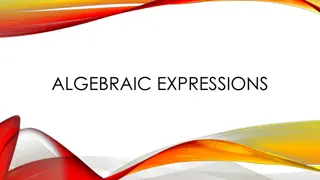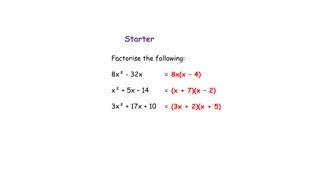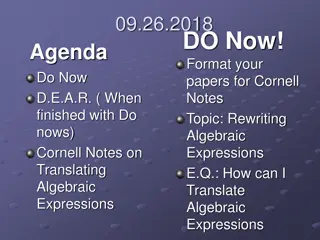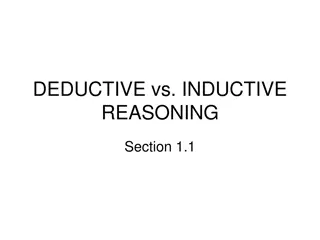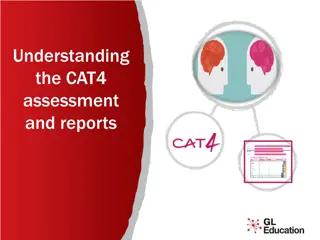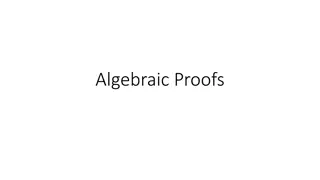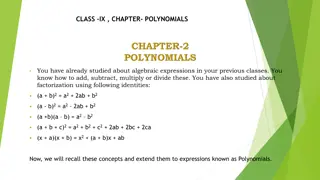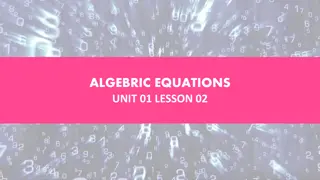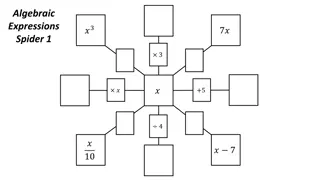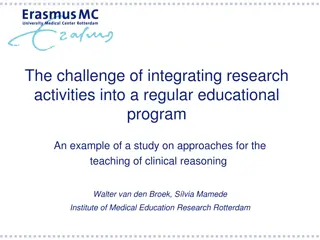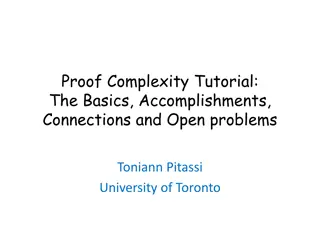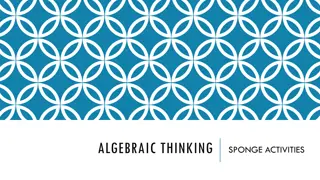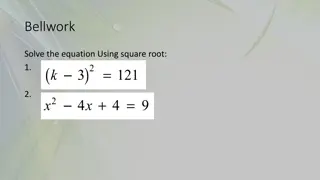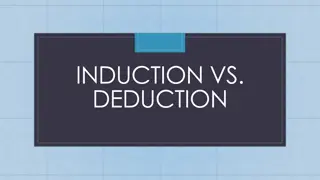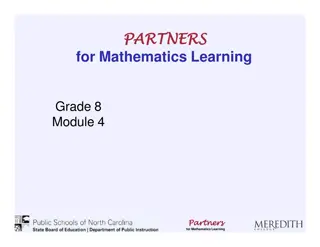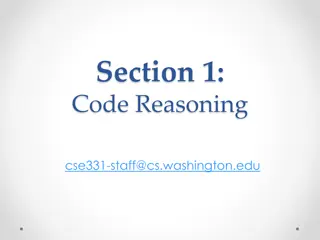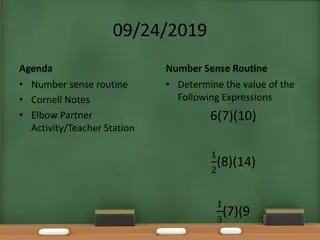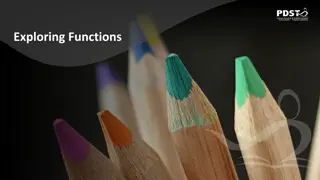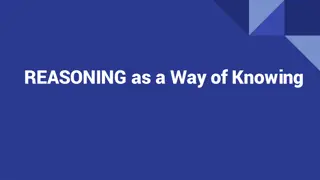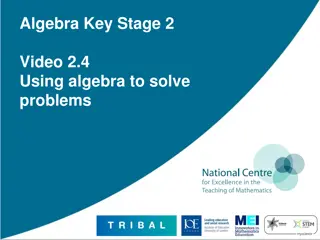Exploring Algebraic Reasoning in Education Research
Delve into the journey of Preparing to Teach Algebra (PTA) with insights on research projects, challenges faced, and the development of frameworks and protocols. Discover the algebraic focus with justification and argumentation in educational settings. Learn about important concepts, implementation challenges, and the impact of algebra on students' academic opportunities. Meet the PTA team and advisory board shaping the future of algebra education.
Download Presentation

Please find below an Image/Link to download the presentation.
The content on the website is provided AS IS for your information and personal use only. It may not be sold, licensed, or shared on other websites without obtaining consent from the author. Download presentation by click this link. If you encounter any issues during the download, it is possible that the publisher has removed the file from their server.
E N D
Presentation Transcript
Preparing to Teach Algebra (PTA) JILL NEWTON PURDUE UNIVERSITY
Todays Talk Description of algebra projects PTA journey/project team Rationale for the PTA study Research questions/Methodology/Timeline What have we learned so far? What challenges have we faced? Framework development Protocol development Survey development Preliminary findings Questions/Comments
Algebra as a Research Focus Justification and Argumentation: Growing Understanding of Algebraic Reasoning (JAGUAR) Megan Staples (University of Connecticut) Sean Larsen (Portland State University) Pre-service Secondary Teachers Mathematical Knowledge for Teaching Equations & Inequalities Rick Hudson (University of Southern Indiana) Aladar Horvath, Sarah Kasten, & Lorraine Males Preparing to Teach Algebra (PTA) Yukiko Maeda (Purdue University) Sharon Senk
PTA Journey EXCITE Conference (MSU, 2008) Two algebra groups (K-12, TE) K-12 Mary Kay Stein, Ed Silver, Glenda, Beth, etc. TE Raven, Kristen, Mike, Sandra, Sharon, Jill, Betty, etc. NSF REESE, 2009 Important concept Implementation challenges - participation Scale down Revised, NSF REESE, 2010 (Funded) Sharon Senk, Jill Newton, Yukiko Maeda Scale down more
PTA Team MSU PI - Sharon Senk GAs Jia He & Eryn Stehr Purdue PIs Yukiko Maeda, Jill Newton GAs Vivian Alexander, Hyunyi Jung, Alexia Mintos, & Kari Wortinger/Tuyin An Undergraduates Adam Hakes, Jules McGee/Ali Brown Project Team Meetings MSU, Purdue, Advisory Board Meeting (MSU), South Haven
PTA Team Advisory Board Tom Hoffer, Joint Center for Education Research at NORC Eric Hsu, San Francisco State University Karen King, NCTM Vilma Mesa, University of Michigan MSU Internal Advisory Board Dorinda Carter Andrews Robert Floden Glenda Lappan Jean Wald Suzanne Wilson
Rationale for the Study Algebra as foundation for advanced mathematics and gatekeeper for post-secondary opportunities (e.g., Kilpatrick & Izs k, 2008; Moses & Cobb, 2001) Algebra course and/or end-of course exam requirement in most states and increasing diversity of population of students taking algebra (e.g., Perie, Moran & Lutkus, 2005) Failure rates in algebra are high (e.g., Loveless, 2008) Debates about how algebra should be taught (e.g., Chazan, 2008; Kieran, 2007)
Rationale for the Study Common Core State Standards for School Mathematics (CCSSM) includes both old and new visions of algebra in three strands: (1) Algebra, (2) Functions, (3) Modeling (CCSSM, 2010) Research base about teaching algebra is thin, and lacks strong connection to the research on students learning algebra. (Kieran, 2007) Most extant mathematics teacher education literature was written by researchers studying aspects of programs offered by their own institutions. (Adler et al., 2005)
Rationale for the Study Both strong content knowledge (a body of conceptual and factual knowledge) and pedagogical content knowledge (understanding of how learners acquire knowledge in a given subject) are important (NRC, 2010, p. 4) Prospective high school teachers of mathematics should be required to complete the equivalent of an undergraduate major in mathematics, [including] a 6-hour capstone course connecting their college mathematics courses with high school mathematics. (CBMS, 2001, p. 7)
Rationale Great variation exists across mathematics teacher education in the US (less variation in other countries); less mathematics than A+ countries, also more general pedagogy than math pedagogy. (Schmidt, Cogan, & Houang, 2011) More students taking algebra earlier; underprepared students admitted to algebra do not fare well (without additional supports); different versions of algebra are being created. (Stein, Kaufman, Sherman, & Hillen, 2011)
Research Question What opportunities do secondary mathematics teacher preparation programs provide to learn about: Algebra Algebra teaching Issues in achieving equity in algebra learning The algebra, functions, and modeling standards and mathematical practices described in the Common Core State Standards for Mathematics (CCSSM)?
Methods National survey of a stratified random sample of at least 200 secondary teacher preparation programs Carnegie classification for stratification, oversampled 2x Case studies of learning opportunities in four purposefully chosen secondary teacher preparation programs Doctoral-granting university with very high research activity Large master s level universities (rural/suburban, urban) Focus groups with student teachers at each of the case study programs
Timeline Year 1 Develop, pilot, and revise instruments Survey Frameworks Interview protocols (Instructor, Focus group) Select sample Locate contact people at institutions in survey sample Collect and analyze pilot case study data Three institutions Survey think-aloud Five instructor interviews & one focus group interview
Timeline Year 2 Administer revised survey Analyze, Summarize, & Disseminate Identify courses at three case study institutions Collect course materials (with site coordinator) Interview instructors Conduct focus groups Administer survey Transcribe, Analyze, Summarize, & Disseminate Identify fourth case study institution Collect course materials (with site coordinator)
Timeline Year 3 Identify courses at fourth case study institution Collect course materials (with site coordinator) Interview instructors Conduct focus groups Administer survey Transcribe, Analyze, Summarize, & Disseminate Survey Continue analysis, summarizing, & dissemination Three case study sites Continue analysis, summarizing, & dissemination
What have we learned so far? Framework development Stay focused on Algebra Select a set of big ideas in Algebra Nature of Algebra (CBMS, 2001; InTASC, 1995) Reasoning & Proof (InTASC, 1995; NCTM, 2009; TNE) Contexts & Modeling (CCSSM, 2010; NCATE, 2003) Algebra Connections (CBMS, 2001; NCTM, 2000) Tools & Technology (CBMS, 2001; CCSSM, 2010) Equity in Algebra Learning (NBMS, 2010; NCTM, 2000) Functions (InTASC, 1995; NBMS, 2010; NMP, 2008) History of Algebra (NBMS, 2010; NCATE, 2003)
Connections Within algebra Between algebra & other mathematical fields Example: symmetry groups of polygons <-> geometry of transformations Between algebra & other non-mathematical fields Example: quadratic functions used to model motion of projectile in physics Between college level algebra & school algebra Example: Rings, integral domains, and fields related to the number systems used in high school algebra
What have we learned so far? Protocol development Investigated semi-structured and focus group protocols Developed series of parallel questions for interviews Instructor interview What are the big ideas that you would like students to take away from this course? To what extent does your course emphasize functions? Focus group interview Will you please give us some examples of experiences from this list in which you had opportunities to either learn algebra or learn how to teach algebra? What experiences have you had to learn about functions or to learn to teach functions?
What have we learned so far? Protocol development Challenges Typical interviewing challenges Probing Avoiding evaluative language Consistency across interviewers Parallel structures of instructor and focus group interviews Maintaining focus on algebra Sharing big ideas (When? How?)
What have we learned so far? Survey development Reviewed items from related surveys The Mathematics Teaching in the 21st Century (MT21) Study (Schmidt, et al., 2007) TEDS-M Institutional Program Survey (Tatto, et al., 2008) Secondary Mathematics Teacher Education Programs in Iowa Survey (Murdock, 1999) 2000 National Survey of Science and Mathematics Education School Mathematics Program Questionnaire (Horizon, Inc., 2000). Developed items to collect information to answer our research questions
What have we learned so far? Survey development Challenges Locating program information and contact person Diversity and complexity of programs across diverse institutions 4 year/5 year? Degree? Online? Licensure by exam? Variable knowledge of program contact person Department? Instructor/Coordinator? Limited previous studies on mathematics teacher education
Survey Item (Program characteristics) What is the most common degree that pre-service secondary mathematics teachers obtain upon completion of the secondary mathematics teacher education program at your institution ? 4-year Bachelor's degree 5-year Bachelor's degree Post-baccalaureate(i.e., for licensure only, not for Master's degree) Master's degree and initial certification (e.g., M.A.T. not for previously certified individuals) No degree Other: Please specify___________________
Survey Item (Research questions) To what extent does the secondary mathematics teacher education program provide opportunities to learn in the following areas? Great extent Some extent Little extent No extent Do not know Opportunity to Learn Algebra Algebra teaching Issues in achieving equity in algebra learning Algebra as described in the Common Core State Standards in Mathematics (CCSSM)
Survey Item (CCSSM) How has the recent release of Common Core State Standards for Mathematics (CCSSM) influenced your secondary mathematics teacher education program? (Check the one answer that best describes the situation at your institution.) Discussions about CCSSM have not begun in our program. Discussions about CCSSM are ongoing, but no programmatic changes have been made. Minor changes have been made to the program as a result of CCSSM. Major changes have been made to the program as a result of CCSSM. I am not familiar with CCSSM. Briefly describe the changes that have occurred in your program based on CCSSM.
Preliminary Findings Contexts & Modeling Instructors seemed to hold a similar conception of the purpose of modeling; that is, one which connects the use of mathematics to solve real world problems (e.g., loan repayment schedules, population growth, and security problems). For example, the Structure of Algebra instructor described mathematical modeling as the process of using mathematics to represent phenomena that one seeks to understand. The program provided a wide range of opportunities for PSTs to engage with C&M related to algebra through course activities and assignments, including using C&M to motivate course topics. Two of the instructors interviewed alluded to the motivational quality of C&M that could encourage student interest and persistence in mathematics. PSTs reported that opportunities to engage in C&M arose in the following courses in the program: Math Modeling, Differential Equations, Math Software, Probability & Statistics, Geometry, Abstract Algebra, Calculus, and Mathematics Methods.
Preliminary Findings Connections Within algebra A seminar course instructor stated that PSTs were encouraged to consider relationships among concepts in different chapters in the textbook. With other mathematical fields Middle School Math Methods course instructor emphasized algebra lessons including geometric or statistical concepts in the micro-teaching and the Connected Mathematics Project lessons. In addition, a PST said, When you are in geometry, you just can't say geometry, because we need algebra to complete the proofs. With non-mathematical fields Differential Equations instructor explained that students develop functional models for certain physical situations that will often involve exponential functions or sines and cosines. Between high school and university-level algebra. Goal in the Abstract Algebra course: Make a connection between what they [PSTs] have already learnt through high school and to new mathematical systems.
Preliminary Findings Reasoning & Proof Instructors reported that R&P played a significant role in their courses. PSTs also reported having opportunities to access content knowledge and pedagogical content knowledge related to R&P. PSTs opportunities in mathematics courses: Learn about axiomatic systems by examining what qualifies as a proof, differences between definitions and theorems, and specific techniques of constructing proofs, and proving the equivalence of two statements. Fewer chances to engage in making conjectures. The Capstone Course instructor said that making conjectures did not arise often in classes although he thought conjectures are important because they give the sense that mathematics is alive. PSTs opportunities in methods courses: Discuss conceptions of proof as related to K-12 mathematics, engage in activities such as generalizing, formalizing and refining mathematical arguments. Engage in designing tasks and questions to support students learning of R&P. Both instructors of methods courses and PSTs in the focus group mentioned class activities related to one PST called what qualifies as proof.
Thank you! COMMENTS/QUESTIONS?



